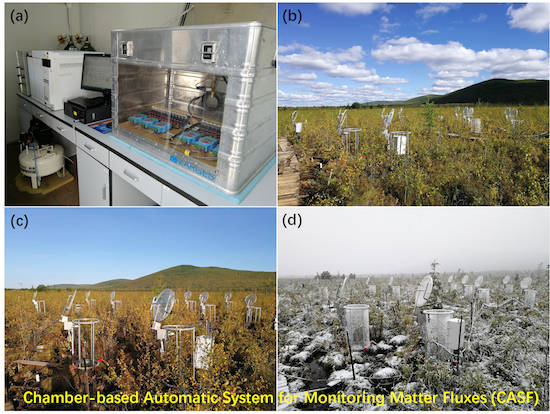Chamber-based Automatic System for Monitoring Matter Fluxes (CASF)
Static chamber and eddy covariance methods are the most common methods to measure greenhouse gas (GHG) fluxes between biosphere and atmosphere. The application of the eddy covariance method is limited by the strict requirements of fully developed turbulence, and horizontal and uniform terrain. The static chamber method is extensively adopt for GHG flux measurements because of the advantages of flexible operation, low detection limit and adaptability to complex terrain. However, the great majority of flux measurements have been conducted with the manual static chamber method, which has the clear disadvantages of low frequency and huge demands of labour and time. The automatic static chamber method can characterize well the temporal variation of GHG fluxes; capture accurately the random and rapid effects of human activity and climate change; quantify continuously the annual total exchanges. Thus, the development of chamber-based automatic system is a key technology in the research fields of biogeochemical cycle and global change.
The research group of carbon and nitrogen cycling in Institute of Atmospheric Physics, Chinese Academy of Sciences develops the chamber-based automated system for monitoring matter fluxes (CASF). The CASF system can measure simultaneously methane (CH4), nitrous oxide (N2O), carbon dioxide (CO2) and water vapor (H2O) fluxes with hourly frequency, or CO2 and H2O fluxes with half-hour frequency. The CASF system consists of five parts: automated chambers and units of environmental factor, analysis, major control and power supply. Main features of CASF system are (a) simultaneous flux measurements of four GHGs (CH4, N2O, CO2 and H2O) at twelve positions (three treatments with four spatial replicates for each treatment, or two treatments with six spatial replicates for each treatment), (b) considerable reduction in chamber effects (highly transparent chamber, position rotation for each chamber, nonlinear flux calculation, automatic opening of chamber lids for rain events, rubber seal and ventilation tube), (c) adaptability to different ecosystems (resizable chamber, operating temperature: -20 – 65 °C, and low detection limit), and (d) easier-to-operation (high automation for flux measurement and calculation using CAS-Flux and IAP-Flux Software, low power demand and remote control).
